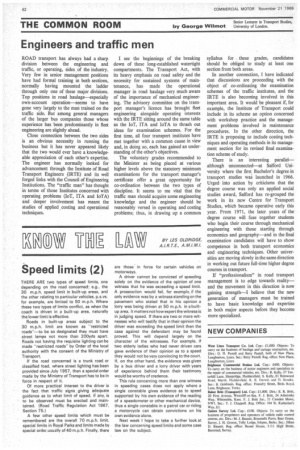MOM
Page 64

If you've noticed an error in this article please click here to report it so we can fix it.
EAV
BY LES OLD RIDGE, A.I.R.T.E., A.M.LM.I.
Speed limits (2)
THERE ARE two types of speed limits, one depending on the road concerned: e.g., the 30 m.p.h. speed limit in built-up areas, and the other relating to particular vehicles, p.s,vs. for example, are limited to 50 m.p.h. Where these two types of limits conflict, as when the coach is driven in a built-up area, naturally the lower limit is effective.
Roads in built-up areas subject to the 30 m.p.h. limit are known as "restricted roads"—to be so designated they must have street lamps not more than 200yds apart. Roads not having the requisite lighting can be made "restricted roads" by Order of the local authority with the consent of the Ministry of Transport.
If the road concerned is a trunk road or classified road, where street lighting has been provided since July 1957, then a special order made by the Ministry of Transport has to be in force in respect of it.
Of more practical interest to the driver is the fact that traffic signs giving adequate guidance as to what limit of speed, if any, is to be observed must be erected and maintained, ;Road Traffic Regulation Act 1967, Section 75./ A few other speed limits which must be remembered are the overall 70 m.p.h. limit, special limits in Royal Parks and limits made by special orderusu ally of 40 m.p.h. Finally, there are those in force for certain vehicles on motorways.
A driver cannot be convicted of speeding solely on the evidence of the opinion of one witness that he was exceeding a speed limit. A prosecution would fail, for example, if the only evidence was by a witness standing on the pavement who stated that in his opinion a lorry was being driven at 50 m.p.h. in a builtup area. It matters not how expert the witness is in judging speed. If there are two or more witnesses who will testify that in their opinion the driver was exceeding the speed limit then the case against the defendant may be found proved. This will depend largely on the character of the witnesses. For example, if two elderly ladies who had never driven cars gave evidence of their opinion as to a speed they would not be very convincing to the court. If, on the other hand, the evidence was given by a bus driver and a lorry driver with years of experience behind them their testimony would be worthy of credence.
This rule concerning more than one witness in speeding cases does not apply where a single constable gives evidence as to speed supported by his own evidence of the reading of a speedometer or other mechanical device, thus a single constable in a patrol car or riding a motorcycle can obtain convictions on his own evidence alone.
Next week I hope to take a further look at the law concerning speed limits and some case law on the subject.




































































































